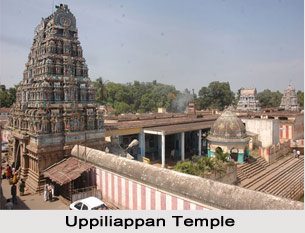 The Uppiliappan Temple is a famous temple of Lord Vishnu located near the village of Thirunageswaram in the Thanjavur district of Tamil Nadu. The temple is also known as Thiruvinnagar, Oppliyappan Temple, Oppiliappan Kovil and Oppiliappan Sannidhi. The temple is dedicated to Lord Uppiliappan Perumal and his consort Bhumi Devi and her father sage Markandeya. Uppiliappan Temple is one of the pilgrimage centres of South India and is also known as South Tirupati. The temple is regarded as one of the 108 Divya Desams.
The Uppiliappan Temple is a famous temple of Lord Vishnu located near the village of Thirunageswaram in the Thanjavur district of Tamil Nadu. The temple is also known as Thiruvinnagar, Oppliyappan Temple, Oppiliappan Kovil and Oppiliappan Sannidhi. The temple is dedicated to Lord Uppiliappan Perumal and his consort Bhumi Devi and her father sage Markandeya. Uppiliappan Temple is one of the pilgrimage centres of South India and is also known as South Tirupati. The temple is regarded as one of the 108 Divya Desams.
Legend of Uppiliappan Temple
According to the legend of Uppiliappan Temple Tulsi Devi once requested Lord Vishnu to give her a place on his chest like Goddess Lakshmi. The Lord told her that Lakshmi would appear as Bhoomidevi at a holy place near Kumbakonam as the daughter of sage Markandeya. He told Tulsi to go there and take the form of Tulsi plant at the sage`s hermitage. Then Lakshmi would appear under the Tulsi plant as Bhoomidevi. The Lord would marry Bhoomidevi and thus the glory of Tulsi would become known to all.
Architecture of Uppiliappan Temple
The Uppiliappan Temple is adorned with beautiful marble mandapa located on the western side in the inner prakaram. The deities rest in this mandapa before being taken out during the pancha-parva utsavam. There is another mandapa located on the northern side. The dolotsavam is performed for the deities here. The temples of Lord Rama, Lakshmana, Sita and Lord Hanuman have been beside the mandapa. During festivals the lord along with his consort rest in the sacred bed chamber adorned with beautiful mirrors. The temple has a vahana mandapa and a library. Devotees can also another mandapa located on the banks of the pushkarini. It is adorned with 8 carved pillars. In this mandapa the and another mandapa with 8 carved pillars on the banks of the pushkarini where the annual float festival takes place during the months of January to February. The huge and spacious Kotimandapa can be seen to the south of the Garuda shrine. It is used for various religious purposes like celebration of the annual Kalyana Utsavam. Music and dance programmes are also organised during the festival. Prarthana Kalyana Utsavams are also performed here. There are 2 mandapas at the end of the Sannidhi Street. One houses a small chariot and the other is used during the big chariot festival. Marriages are also conducted here. There are two huge marriage halls located in front of the temple. The temple houses a vimana or tower that has been named as Suddhananda, meaning `pure happiness`. A pushkarini or temple tank is also present in the temple known as Ahoratra Pushkarini. It means that bathing is permissible here both during day and night. However, nowadays bathing is permitted here, only when the temple is kept open for darsan. Apart from this there are three holy rivers known as Dakshina Ganga, Dakshina Yamuna and Dakshina Godavari. There is a small garden by the side of the outer prakara of the Uppiliappan Temple. Besides this there is also a much bigger garden about haldf km to the south of the temple.
Festivals of Uppiliappan Temple
Pujas and festivals are conducted in the temple according to Vaikhanasa Agama sastras. Pujas are performed six times daily, starting with Viswarupa Darsanam in the morning with recitation of Suprabhatam, Prapatti and Mangalam composed in praise of this deity. Kalyana utsavam, Garuda Sevai, Golden chariot, Brahmotsavam, Dolotsavam, Nitya-aradhana, mirror-room seva, and Darbar seva are also performed. Sri Ramanavami is celebrated for 10 days on a grand scale accompanied by music and dance performances. On the concluding day, kanakabhishekam and Rama Pattabhishekam are conducted on a majestic scale. It is attended by thousands of devotees.
The Temple is located about 7 kilometres (4.3 mi) from Kumbakonam and is reachable by the State highway SH-147.





















